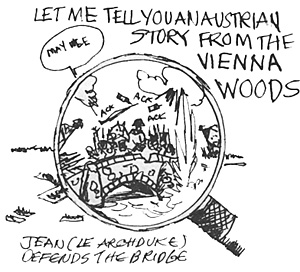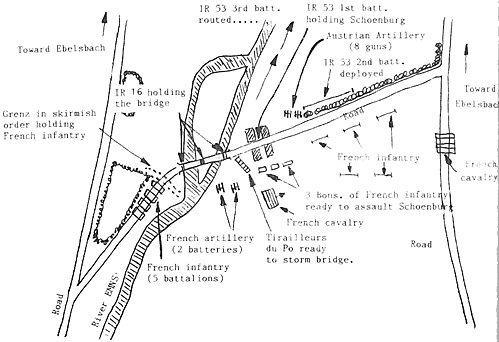 NOTE: Many problems have surfaced in the first phase of the battle of EBELSBACH. We are going to address the very basic ones outlined by Mike in "JEROME'S CORNER" (pp.57).
NOTE: Many problems have surfaced in the first phase of the battle of EBELSBACH. We are going to address the very basic ones outlined by Mike in "JEROME'S CORNER" (pp.57).
(1) ON PRISONERS:
Mike is partially right when he says that, in our rules, we have neglected the question of prisoners as such. However, it's partially wrong since we did not differentiate them from the other casualties (killed, wounded) in close-combat, rout, etc. We simply considered total CASUALTIES and they were removed from their unit as such. We even had a rule - never used - which removed casualties (obviously most of them prisoners) from a cavalry unit when failing the morale check before melee (or close-combat). Furthermore, we also have a SURRENDER RULE, which reads as follows: Surrender of a Unit - If a unit, completely surrounded, suffers a morale loss ( or any reason) and is consequently unable to withdraw without forcing a melee, it must surrender. The unit is removed from the game.
That rule - don't forget - is the complement of casualty concept, as outlined above, and which does not differentiate - in other circumstances - the type of casualty inflicted to the enemy. In the case covered by our "Surrender-of-a-Unit" rule, there is a clear need to consider the surrender as the a way to inflict 100% casualties to a unit which indeed has to be eliminated - SOMEHOW - from the enemy effectives.
No doubt that the above surrender rule can be improved and that is the object of our discussion. As a first step let us consider the situation on the bridge, and our present rules that cover it. We'll provide our answer in our next issue.
(2) SITUATION ON THE BRIDGE:
It's turn #14 (9.20AM) and Gajoli's brigade has been roughly handled - to say the least - by Claparede's Division. (See Note 1) The map illustrates the situation. Schoenburg is still occupied by the 1st battalion of IR.53. It is supported on the left by a (brigade) battery of 8 3-pdr and the 2nd bat. of IR.53. The 3rd bat. of IR.53, which occupied the space between Schoenburg and the bridge has been routed after suffering heavy casultie# from the fire of two French batteries (8-pounders).
The bridge is occupied by the single battalion of IR 16, broken down into its 3 divisions of 2 companies each (see Note 2), one division at each end of the bridge and the 3rd in the center as shown on the map. Under the heavy artillery fire of the two French batteries, the division of IR 16 occupying the bridge (on the Schoenburg side) was attacked, defeated and routed by the Tirailleurs du Po.
We have now a situation very similar to the one encountered at Ebelsberg - even the Tirailleurs du Po are involved! The Austrians of the 1st division have been routed (some or all of them should surrender, see Mike's proposed rule page 59) and they may even throw in disorder the 2nd division (of IR 16) standing on the middle of the bridge. Anyhow that second division has to check for (1) being disordered (2) fear of disaster. Like at Ebelsberg, the Tirailieurs du Po are ready to storm the bridge.
The fear of disaster check should even be increased in that situation since:
- (1) the battalion is almost unsupported (except for the Grenz on their right - in skirmish order - facing some 6 battalions of French troops, i.e. overwhelming forces).
(2) The battalion has suffered casualties from the flank (usual penalty 15 chips).
If the Tirailleurs du Ro are successfulin routing IR 16, the Grenz will find themself also in a precarious situation since they'll be under attack from the rear.

Note the length of the bridge (4.5 inches i.e 225 yards). The Grenz are holding the French skirmishers on the left bank. On the right of Schoenburg, note the location of the 2nd battalion of IR. 53. The French artillery has been excellently positioned by Claparede (our Jim Bello).
Since we are speaking of morale, we should also consider the. case of the 1st battalion of IR 53 standing alone, in Schoenburg - unsupported on its right - under the pressure of overwhelming forces, ready to assault the village. That battalion should also check morale at a substantial penalty.
What is going to happen is very interesting. My guess is that the 2 remaining divisions of IR 15, on the bridge, are going to withdraw at best and perhaps rout ...We'll see that in our next issue.
NOTE: "Je suis dins un bean merdier!", (I don't try to imitate Cambronne et Waterloo, but simply try to describe precisely the precarious situation 7 put myself into - I can only blame myself since T designed the game...but the battle is far to be over...) I can translate my expression as: "I am in deep, deep trouble!" (however, the French word ? used is more explicit and does not have the vulgarity of its literal English translation). Mike is delighted. He has been awaiting such a situation for a long time... I must concede that his drawings covering the situation are to the point... However, why did he had to get so nasty and show my dear bottles of line wines flying around' That's unfair, lie sure knows how to hurt a man's feelings! NOTE 2: This is done according to one of our rule which reads:
Irregular Position and Town Order: Battalions can be broken to fit irregular positions or town. There are examples of battalions broken up in divisions, 1/2 battalions, etc.
Back to Empire, Eagles, & Lions Table of Contents Vol. 1 No. 84
Back to EEL List of Issues
Back to MagWeb Master Magazine List
© Copyright 1985 by Emperor's Headquarters
This article appears in MagWeb.com (Magazine Web) on the Internet World Wide Web.
Other articles from military history and related magazines are available at http://www.magweb.com
